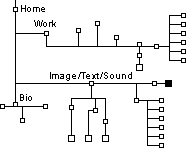|
|
Anna Oppermann: Besinnungsobjekte über das Thema Verehrung -- Anlaß Goethe
I. in: the brochure for the exhibit and television broadcast Goethe in Farbe, Hessischer Rundfunk, Frankfurt 1982
 II. expanded and reworked version in the catalog: Vergangenheit, Gegenwart, Zukunft, Stuttgart 1982, pp. 88-91 II. expanded and reworked version in the catalog: Vergangenheit, Gegenwart, Zukunft, Stuttgart 1982, pp. 88-91
 English translation English translation
 III. also in the catalogs: Anna Oppermann Ensembles 1968-1984, Hamburg and Brussels 1984, pp. 172-183 and in: Anna Oppermann. Das Hehre und das Banale. Besinnungobjekte über das Thema Verehrung -- Anlaß Goethe, Weimar 1996, p. 7 III. also in the catalogs: Anna Oppermann Ensembles 1968-1984, Hamburg and Brussels 1984, pp. 172-183 and in: Anna Oppermann. Das Hehre und das Banale. Besinnungobjekte über das Thema Verehrung -- Anlaß Goethe, Weimar 1996, p. 7
 English translation English translation |
|
